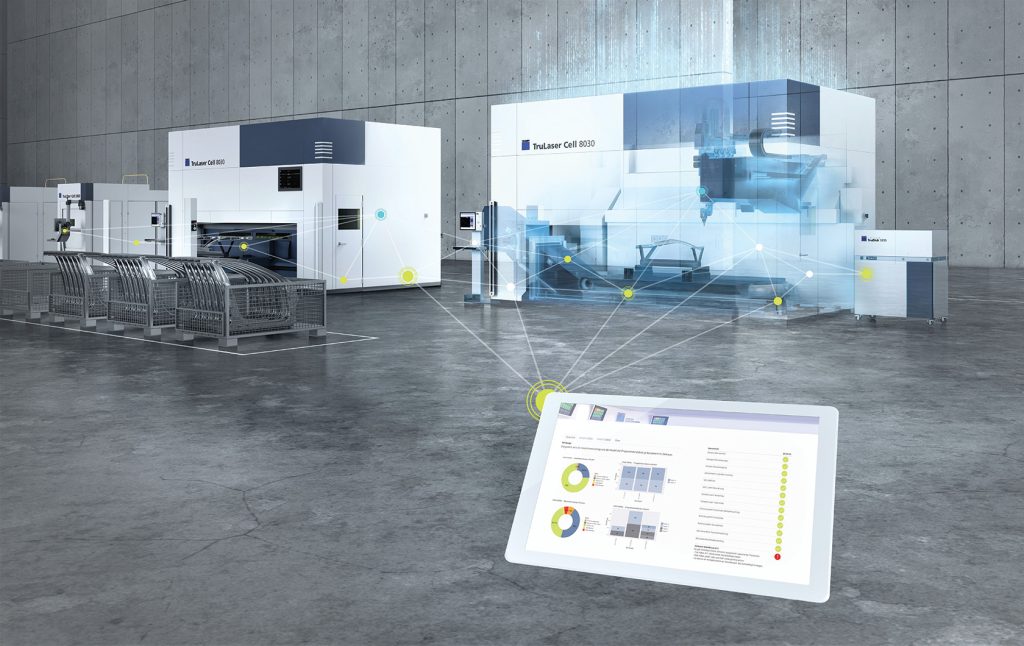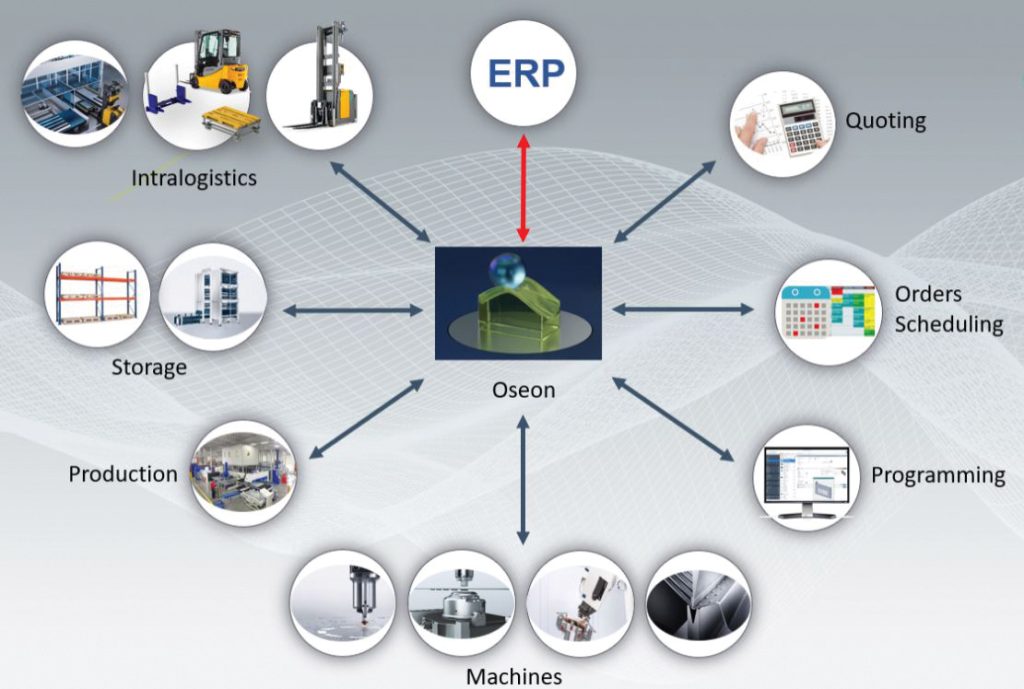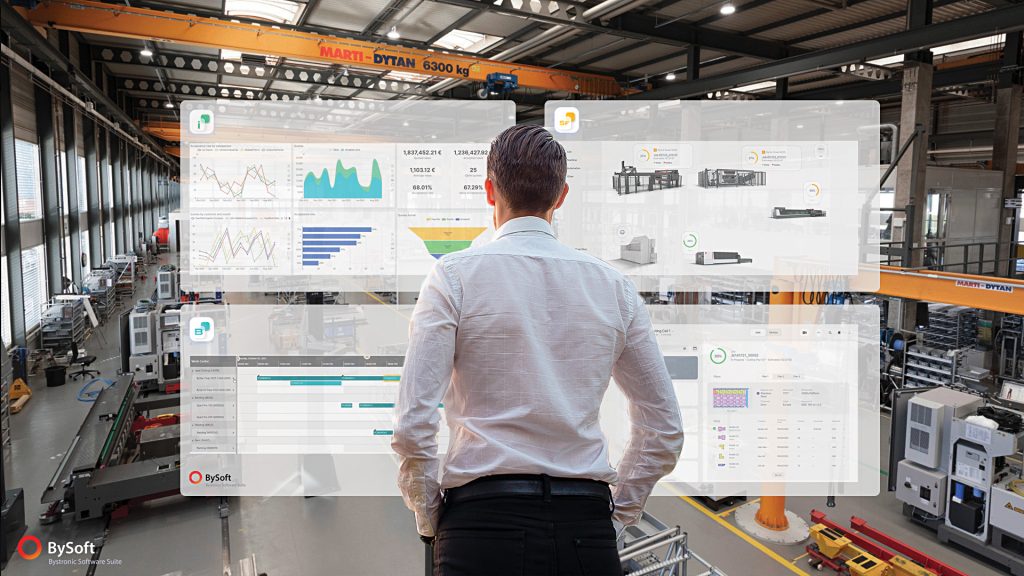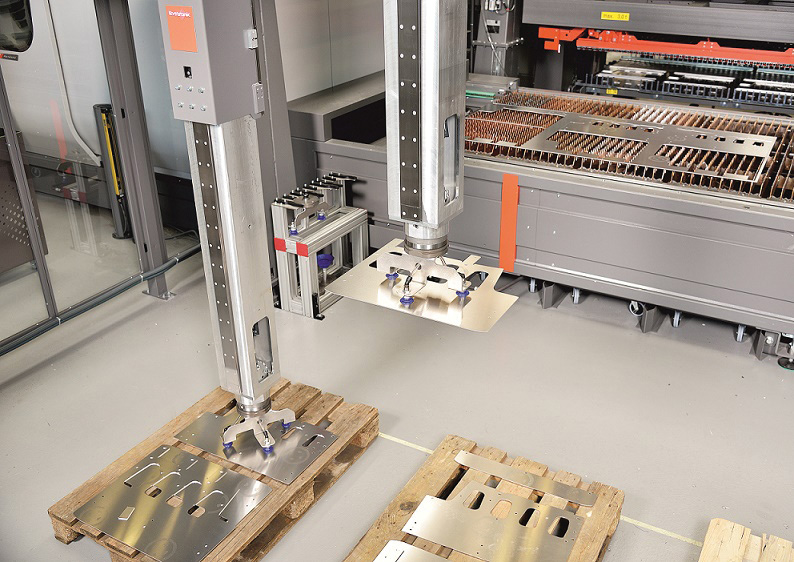From automated storage systems to robotic press brake tending, sheet metal fabricators have plenty of ways to boost productivity. Is your shop ready to invest? PHOTO courtesy TRUMPF.
By Kip Hanson
Flexible manufacturing systems (FMS) for sheet metal fabrication are nothing new. For instance, many of us remember the 1994 introduction of Finn Power’s Night Train FMS, one of the first such systems to gain widespread name recognition. But well before that came Salvagnini’s S4+P4 line, made by combining the company’s S4 punching-shearing machine with its P4 panel bender, and said to be the world’s first FMS.
That was in 1979. Six years later, General Electric put the concept to the test. The manufacturing giant turned out the lights and cranked up production by joining several S4+P4 lines, creating a “fully automated factory” that remained in operation until 2012.
Other machine tool builders have their own automation history lessons to tell, and today, every major brand has some form of FMS. These include the Mazak Optonics Quick Cell, the Tower Automation System (TAS) from LVD, Amada’s AMS line of laser automation solutions, and systems from TRUMPF and Bystronic, which we’ll hear more about shortly.
Top of the list
The heart of any FMS—at least from an electromechanical perspective—is its stacker or tower system. These elevator-like devices serve a dual purpose—efficient storage of otherwise bulky metal sheets, and even more efficient feeding of this raw material to an attached CNC punching machine, laser cutter, or combo punch/laser machine. As many experts will tell you, investment in one of these systems brings significant rewards.
Yet sheet metal shops attempting to develop an automation strategy have much more to think about than what stacker to use (despite its importance). What about the downstream processes like bending, forming, painting, and assembly? Should we use robots or cobots? Which tooling systems are the most automation-friendly? What part numbers or processes should we tackle first? How about integration with the shop’s software systems? What about operator training, and are there any safety regulations to worry about? It seems that automation—though increasingly necessary in this labor-starved world—is not for the faint of heart.
One often overlooked question sits near the top of any Lean practitioner’s checklist: where’s the bottleneck? For many shops, this has long been the laser cutter (and the turret punch before that), which helps explain the emphasis on towers described earlier.
Yet, as Brendon DiVincenzo points out, that paradigm is poised to shift. “It’s a fairly open secret that we’ve developed a 30-kW laser cutter, which could be a game-changer to our industry,” says the head of solutions for the Americas market region at Bystronic Inc. “Over the past few years, and particularly now, the laser is no longer the primary factor in determining the speed at which items can be shipped and revenue can be recognized.”
Automation isn’t automatic
As a result, shops have begun looking at additional ways to maximize their production velocity, DiVincenzo says. “Now, the focus is more on optimizing the cutting process for downstream operations.”
This optimization includes strategies like adding relief cuts around sharp corners to make it easier for humans to remove parts from the skeleton, utilizing waste destruct sequences properly, and ensuring that slugs and other debris fall as intended, without causing collision risks. But shops should also take a hard look at automatic sorting systems and conveyor removal of finished parts, as these can reduce labour costs significantly.
Demand for these solutions is on the rise, he adds, noting that companies who invested in them a few years ago are now coming back for more. “Whether it’s a small job shop that bought an automated press brake to run high-mix, low-volume work or a larger production facility that moved to a full-blown FMS, it doesn’t take long to realize the benefits.”
There’s no Easy Button, however.
“Automation in all its many forms is certainly capable of lifting the ceiling on your production capabilities, but getting there will require changing your processes,” says DiVincenzo. “Yes, that means optimizing your cutting and forming operations, but it also requires evaluation of seemingly unrelated factors—basic stuff like the best way to order, receive, and store your raw materials, or how to quote jobs when your labour costs have gone down but your capital equipment investment is way up. Automation makes you look at everything differently.”

Defining smart
Although he might have a different opinion on which brand of equipment to use, Claudio Santopietro, head of software sales at TRUMPF Inc., agrees with this last statement. But he also suggests that there’s much more to the automation equation than the hardware, especially once it extends beyond a single machine tool.
“The term ‘smart factory’ refers to a highly automated manufacturing system,” he says. “They represent the future of manufacturing and are therefore gaining in popularity, which is why we developed our Smart Factory in Chicago and are building another at our U.S. headquarters in Farmington, Connecticut. The goal here is to create a production environment where machines can communicate and collaborate, but to do so, you need automated systems with the ability to coordinate various tasks—in other words, the machine tools must be aware of their own jobs as well as those of other machines within the facility.”
Accomplishing this requires a software “brain” to act as the orchestrator, which in TRUMPF’s case is called Oseon, a “comprehensive solution for production and material flow control.” And like all brains, it must share information with other components of the manufacturing ecosystem, including the ERP software, the shop’s programming and nesting tools, and of course, the machine control itself.

Image: TRUMPF
Phone a friend
Pardon the pun, but this last part is a no-brainer for TRUMPF-only fabricators. What about the typical job shop, which probably has some blue and white machines, a few that are green and gray, some brown and orange, and still others bearing the bright red nameplate that Bystronic’s DiVincenzo would immediately recognize; what about integrating them into a smart factory?
Says Santopietro, “You can have all the right automated equipment, but without the right software, like Oseon, to connect the machinery, it isn’t a smart factory. At TRUMPF we have standard interfaces that enable communication with popular hardware or commonly used ERP/MRP/MES software to optimize customers’ overall production process.”
Communication also means speaking with humans when necessary. For all their power and advanced capabilities, robots have been known to drop parts and material handling systems occasionally mishandle sheets. So while the ultimate goal for any smart factory is unattended manufacturing, that goal remains years away. “If a machine has a problem, it’s critical that we can alert someone, usually by text message, to help keep production running,” says Santopietro.

IMAGE: BySoft Suite
Start small. But get started.
Several industry experts can lay claim to the phrase “think big, start small, scale rapidly,” among them futurist Jim Carroll and Jeff Rizzie, director of digital machining at Sandvik Coromant. Whoever’s most responsible, it’s sound advice, which is why Santopietro and his occasional colleague across the FABTECH aisle, DiVincenzo, offer similar advice.
“Our platform is very scalable, so it’s quite common for customers to begin this journey using their current equipment,” says Santopietro. “This helps to minimize capital investment while providing immediate results, but perhaps more importantly, it helps organize the shop’s processes and production flows while preparing the people to work in the factory of tomorrow. Don’t underestimate this last part—the training and mental preparation needed for success. It’s crucial.”

“It’s also crucial to plan for, develop, and invest in an automation solution that fits your needs,” adds DiVincenzo. “Every building is different and every budget is different, as are the shop’s production requirements, the part mix, and the skill levels of its employees. Find a partner who will listen during the sales process, but make sure they’ll be there to support you afterward. There’s a lot more to consider now than what size table to buy and how much power you need. Like I said, automation changes everything.” SMT
